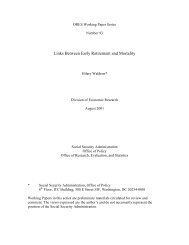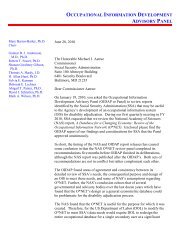Download entire publication - Social Security
Download entire publication - Social Security
Download entire publication - Social Security
Create successful ePaper yourself
Turn your PDF publications into a flip-book with our unique Google optimized e-Paper software.
DeCesaro, Anne, and Jeffrey Hemmeter. 2008. Characteristicsof noninstitutionalized DI and SSI Programparticipants. Research and Statistics Note 2008-02.Washington, DC: Office of Policy, <strong>Social</strong> <strong>Security</strong>Administration.Duncan, Otis D., and Beverly Duncan. 1955. A methodologicalanalysis of segregation indexes. AmericanSociological Review 20(2): 210–217.Gabriel, Paul E., and Susanne Schmitz. 2007. Gender differencesin occupational distributions among workers.Monthly Labor Review 130(6): 19–24.Gabriel, Paul E., Donald R. Williams, and SusanneSchmitz. 1990. The relative occupational attainment ofyoung blacks, whites, and Hispanics. Southern EconomicJournal 57(2): 35–46.Hale, Thomas W. 2001. Lack of a disability measure intoday’s Current Population Survey. Monthly LaborReview 124(7): 38–40.Hale, Thomas W., Howard V. Hayghe, and John M. McNeil.1998. Persons with disabilities: Labor market activity,1994. Monthly Labor Review 121(9): 3–12.Haveman, Robert H., and Barbara Wolfe. 1990. The economicwell-being of the disabled, 1962–1984. Journal ofHuman Resources 25(1): 32–55.Hennessey, John C. 1997. Factors affecting the work effortsof disabled-worker beneficiaries. <strong>Social</strong> <strong>Security</strong> Bulletin60(3): 3–20.Hennessey, John C., and L. Scott Muller. 1995. The effectof vocational rehabilitation and work incentives on helpingthe disabled-worker beneficiary back to work. <strong>Social</strong><strong>Security</strong> Bulletin 58(1): 15–28.Hotchkiss, Julie. 2004. Growing part-time employmentamong workers with disabilities: Marginalization oropportunity? Federal Reserve Bank of Atlanta EconomicReview 3Q: 1–16.Huynh, Minh, Kalman Rupp, and James Sears. 2002. Theassessment of Survey of Income and Program Participation(SIPP) benefit data using longitudinal administrativerecords. SIPP Working Paper No. 238. Washington, DC:Census Bureau.Loprest, Pamela, and David Wittenburg. 2005. Choices,challenges, and options: Child SSI recipients preparingfor the transition to adult life. Washington, DC: UrbanInstitute ( May).McNeil, John M. 1993. Americans with disabilities:1991–1992. Census Bureau, Current Population Reports,P70-33. Washington, DC: Government Printing Office,as cited in Stoddard and others. Chartbook on work anddisability in the United States, 1998. An InfoUse Report.Washington, DC: National Institute on Disability andRehabilitation Research (1998).Miller, Paul W., and Paul A. Volker. 1985. On the determinationof occupational attainment and mobility. Journalof Human Resources 20(2): 197–213.Mulekar, Madhuri S., John C. Knutson, and Jyoti A.Champanerkar. 2008. How useful are approximations tomean and variance of the index of dissimilarity? ComputationalStatistics & Data Analysis 52(4): 2098–2109.Muller, L. Scott. 1992. Disability beneficiaries who workand their experience under program work incentives.<strong>Social</strong> <strong>Security</strong> Bulletin 55(2): 2–19.Muller, L. Scott, Charles G. Scott, and Barry V. Bye. 1996.Labor-force participation and earnings of SSI disabilityrecipients: A pooled cross-sectional times seriesapproach to the behavior of individuals. <strong>Social</strong> <strong>Security</strong>Bulletin 59(1): 22–42.National Council on Disability. 2002. National disabilitypolicy: A progress report (December 2000–December2001). Washington, DC: National Council onDisability.Neumark, David, and Elizabeth T. Powers. 2003/2004. Theeffect of the SSI program on labor supply: Improved evidencefrom <strong>Social</strong> <strong>Security</strong> administrative files. <strong>Social</strong><strong>Security</strong> Bulletin 65(3): 45–60.Ozawa, Martha N., and Yeong Hun Yeo. 2006. Work statusand work performance of people with disabilities. Journalof Disability Policy Studies 17(3): 180–190.Railroad Retirement Board. 2008. Table B1—Number andaverage amount of retirement and survivor annuities incurrent-payment status at end of year, by type of annuitantand fiscal year, 1998–2007. Available at http://www.rrb.gov/pdf/act/ST07partb1.pdf.Schechter, Evan S. 1999. Industry, occupation, and DisabilityInsurance beneficiary work return. <strong>Social</strong> <strong>Security</strong>Bulletin 62(1): 10–22.Schmidt, Peter, and Robert P. Strauss. 1975. The predictionof occupation using multiple logit models. InternationalEconomic Review 16(2): 471–486.Scott, Charles G. 1992. Disabled SSI recipients who work.<strong>Social</strong> <strong>Security</strong> Bulletin 55(1): 26–36.[SSA] <strong>Social</strong> <strong>Security</strong> Administration, 2008a. SSI annualstatistical report. Baltimore: Office of Retirement andDisability Policy, Office of Research, Evaluation, andStatistics, Division of SSI Statistics and Analysis.———. 2008b. State assistance programs for SSI recipients,January 2007. Baltimore: Office of Retirement andDisability Policy, Office of Research, Evaluation, andStatistics, Division of SSI Statistics and Analysis.74 <strong>Social</strong> <strong>Security</strong> Bulletin • Vol. 69 • No. 3 • 2009








